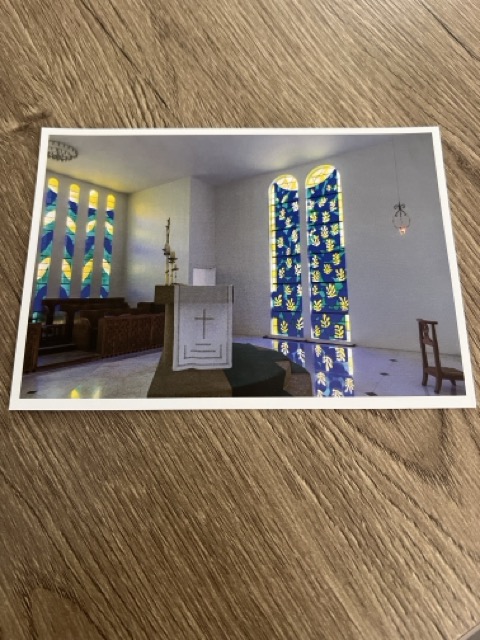Matisse: la Chapelle du Rosaire
Italian Version below*
I dreamed of this place for years, and finally on a European business trip I managed to make a detour to the itinerary to see Matisse’s last masterpiece as he defined it “despite the imperfections”.
As had happened with other artists, including Van Gogh and Gauguin, Matisse also spent the last phase of his life far from the city’s chaos, immersed in Provence’s nature and colors. Leaving Nice we quickly reached Vence.
In this place between 1948 and 1952, Matisse created the small chapel of the Rosary as a sign of gratitude for the care received and friendship for Sister Jacques Mariae, attempting an architectural project for the first time.
The environment is small and linear, with a short nave that ends with a raised presbytery area. Matisse uses essential but extremely effective language.
The visitor is intoxicated by the purity of the geometric lines, by the attention to detail of the ceramics, in one of which there is a Via Crucis and by the memorable stained glass windows.
And the stained glass windows were my biggest dream. It took me years to get to Vence, but every day in my job as a Tour Guide, a few minutes before entering the Sistine Chapel my eyes get lost in this infinite blue.
Suppose you don’t have the chance to get to Vence. In that case, the Vatican Museums host an entire room dedicated to this project by Matisse, in 1973 a bronze casting of the Crucifix for the altar was donated, and in 1980 the life-size cartoons for the ceramics of the presbytery and for the stained glass windows.
– I have always tried to hide my efforts, I have always wanted my works to have the lightness and cheerfulness of spring which never leaves one suspecting the work it took –

All rights reserved*
Follow me on IG: selenia_eyeonart
Matisse a Vence, la Chapelle du Rosaire
Ho sognato questo luogo per anni e finalmente in un viaggio europeo di lavoro, sono riuscita ad apportare una deviazione all’itinerario stabilito per vedere l’ultimo capolavoro di Matisse, come lui stesso la definì, “ nonostante le imperfezioni “
Come era accaduto per altri artisti, Van Gogh e Gauguin, anche Matisse trascorse l’ultima fase della sua vita lontano dal caos cittadino, immerso nella natura e nei colori della Provenza.
Lasciata Nizza, in breve tempo abbiamo raggiunto Vence.
In questo luogo, tra il 1948 ed il 1952, Matisse realizzò la piccola cappella del Rosario in segno di gratitudine per le cure ricevute e riconoscenza ed amicizia per suor Jacques Mariae, cimentandosi per la prima volta in un progetto architettonico.
L’ambiente è piccolo, lineare e con una breve navata che si conclude con una zona presbiteriale rialzata. Matisse utilizza un linguaggio essenziale, ma estremamante efficace.
Il visitatore è inebriato dalla purezza delle linee geometriche, dalla cura dei dettagli delle ceramiche, in una delle quali c’è una Via Crucis, e dalle memorabili vetrate.
Erano proprio le vetrate il mio sogno più grande. Ho impiegato anni per arrivare a Vence, ma quotidianamente nel mio lavoro di Guida Turistica, pochi minuti prima di entrare in Cappella Sistina, i miei occhi si perdono in questo blu infinito.
Se non si ha la possibilità di arrivare a Vence, i Musei Vaticani ospitano un’intera sala dedicata a questo progetto di Matisse.
Nel 1973 è stata donata una fusione in bronzo del Crucifix per l’altare e nel 1980 i cartoni a grandezza naturale per la ceramica del presbiterio e per le vetrate.

– Ho sempre cercato di nascondere i miei sforzi, ho sempre voluto che le mie opere avessero la leggerezza e l’allegria della primavera che non lascia mai sospettare il lavoro che è costato –
Seguimi su IG: selenia_eyeonart
Tutti i diritti sono riservati. E’ vietata qualsiasi utilizzazione, totale o parziale, dei contenuti inseriti nel presente portale, ivi inclusa la memorizzazione, riproduzione, rielaborazione, diffusione o distribuzione dei contenuti stessi mediante qualunque piattaforma tecnologica, supporto o rete telematica, senza previa autorizzazione scritta di Selenia Morgillo.